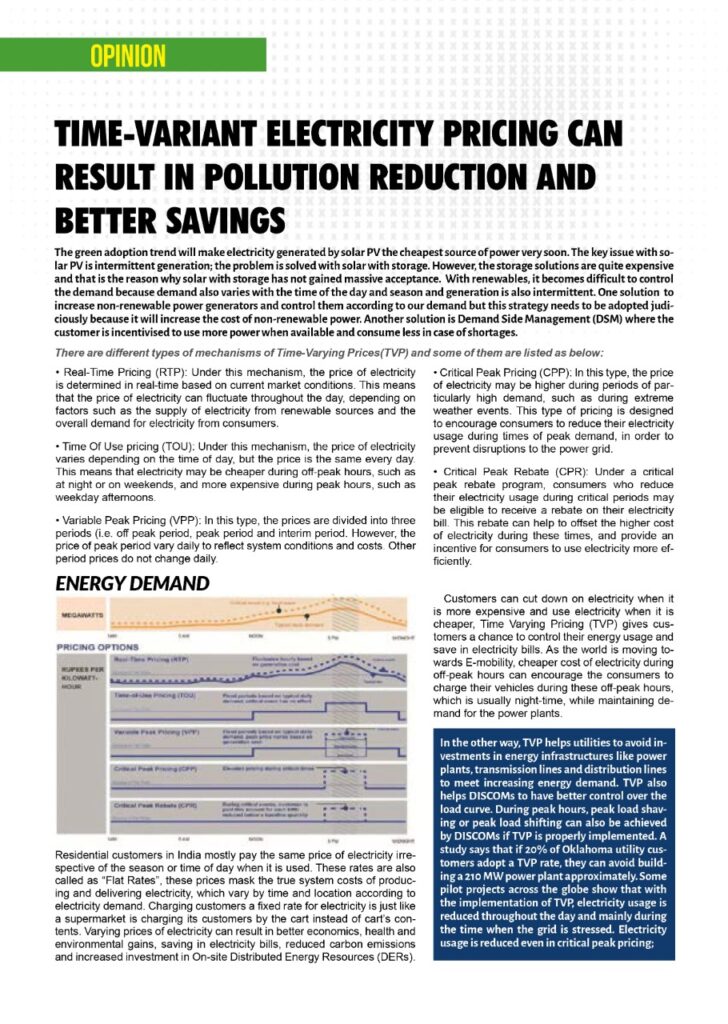Aditya Singhania on Time-Variant Pricing in EQ Magazine
The green adoption trend will make electricity generated by solar PV the cheapest source of power very soon. The key issue with solar PV is intermittent generation; the problem is solved with solar with storage. However, the storage solutions are quite expensive and that is the reason why solar with storage has not gained massive acceptance. With renewables, it becomes difficult to control the demand because demand also varies with the time of the day and season and generation is also intermittent. One solution to increase non-renewable power generators and control them according to our demand but this strategy needs to be adopted judiciously because it will increase the cost of non-renewable power. Another solution is Demand Side Management (DSM) where the customer is incentivized to use more power when available and consume less in case of shortages.
There are different types of mechanisms of Time-Varying Prices(TVP) and some of them are listed as below:
- Real-Time Pricing (RTP): Under this mechanism, the price of electricity is determined in real-time based on current market conditions. This means that the price of electricity can fluctuate throughout the day, depending on factors such as the supply of electricity from renewable sources and the overall demand for electricity from consumers.
- Time Of Use pricing (TOU): Under this mechanism, the price of electricity varies depending on the time of day, but the price is the same every day. This means that electricity may be cheaper during off-peak hours, such as at night or on weekends, and more expensive during peak hours, such as weekday afternoons.
- Variable Peak Pricing (VPP): In this type, the prices are divided into three periods (i.e. off peak period, peak period and interim period. However, the price of peak period vary daily to reflect system conditions and costs. Other period prices do not change daily.
- Critical Peak Pricing (CPP): In this type, the price of electricity may be higher during periods of particularly high demand, such as during extreme weather events. This type of pricing is designed to encourage consumers to reduce their electricity usage during times of peak demand, in order to prevent disruptions to the power grid.
- Critical Peak Rebate (CPR): Under a critical peak rebate program, consumers who reduce their electricity usage during critical periods may be eligible to receive a rebate on their electricity bill. This rebate can help to offset the higher cost of electricity during these times, and provide an incentive for consumers to use electricity more efficiently.
Residential customers in India mostly pay the same price of electricity irrespective of the season or time of day when it is used. These rates are also called as “Flat Rates”, these prices mask the true system costs of producing and delivering electricity, which vary by time and location according to electricity demand.
Charging customers a fixed rate for electricity is just like a supermarket is charging its customers by the cart instead of cart’s contents. Varying prices of electricity can result in better economics, health and environmental gains, saving in electricity bills, reduced carbon emissions and increased investment in On-site Distributed Energy Resources (DERs).
Customers can cut down on electricity when it is more expensive and use electricity when it is cheaper, Time Varying Pricing (TVP) gives customers a chance to control their energy usage and save in electricity bills.
As the world is moving towards E-mobility, cheaper cost of electricity during off-peak hours can encourage the consumers to charge their vehicles during these off-peak hours, which is usually night-time, while maintaining demand for the power plants.
In the other way, TVP helps utilities to avoid investments in energy infrastructures like power plants, transmission lines and distribution lines to meet increasing energy demand. TVP also helps DISCOMs to have better control over the load curve. During peak hours, peak load shaving or peak load shifting can also be achieved by DISCOMs if TVP is properly implemented.
A study says that if 20% of Oklahoma utility customers adopt a TVP rate, they can avoid building a 210 MW power plant approximately. Some pilot projects across the globe show that with the implementation of TVP, electricity usage is reduced throughout the day and mainly during the time when the grid is stressed. Electricity usage is reduced even in critical peak pricing; it is evident that electricity usage is reduced from 9 to 47% during critical events.
To implement TVP successfully, regular energy meters need to be replaced by SMART METERS, which measure electricity use for predetermined periods. Different mechanisms require electricity to be measured in different time periods. Time Of Use pricing (TOU) will require electricity usage measurement for 2-3 different periods of time daily(like peak, off-peak and interim periods). Critical Peak Pricing (CPP) will require to measure electricity usage in each critical period of the month. Implementing TVP on a large scale will require huge investments throughout the system to collect, store, manage and integrate large sets of data generated by smart meters. With TVP, the system can become bidirectional which is one-directional nowadays, it is like a win-win situation for utility as well as customers.
It depends on utility to design TVP mechanism according to its load pattern, needs, type of consumers and many other factors. It depends on utility to offer a proper pricing mechanism, which consumers would adapt. Utility should design such an effective mechanism that is accepted among the huge customer base. TVP price is also a critical factor to consider for utility.
For the successful implementation of TVP, consumer awareness is the most important factor. Consumers should be educated on how they can change their load pattern and with that, they can avail the benefit of TVP with reduced electricity bills. Change in consumer behavior is the key to a successful TVP program.
The utility should do a regular analysis of the implemented program and it should change its tools according to the requirements. They must also understand and evaluate the pattern of how customers are responding to the new TVP options and change tools/pricing according to their needs.
TVP can also help in reducing GHG emissions by giving incentives for investment in clean DERs and on shifting demand when electricity is generated by clean energy sources.




 Online | Privacy policy
Online | Privacy policy
Related Posts
You May Also Like
Bonito Series: Driving Innovation in…
Read MoreTOPCon Series: The Next Generation…
Read MoreValuable Points to Remember During…
Read MoreNavitas Planet Partners with Hysolwin…
Read MoreDriving Towards a Sustainable Future:…
Read MoreWhy Do Top-Grade EVA Sheets…
Read MoreBonito Series: Driving Innovation in…
Read MoreTOPCon Series: The Next Generation…
Read MoreValuable Points to Remember During…
Read MoreNavitas Planet Partners with Hysolwin…
Read MoreDriving Towards a Sustainable Future:…
Read MoreWhy Do Top-Grade EVA Sheets…
Read MoreBonito Series: Driving Innovation in…
Read MoreTOPCon Series: The Next Generation…
Read MoreValuable Points to Remember During…
Read MoreNavitas Planet Partners with Hysolwin…
Read More